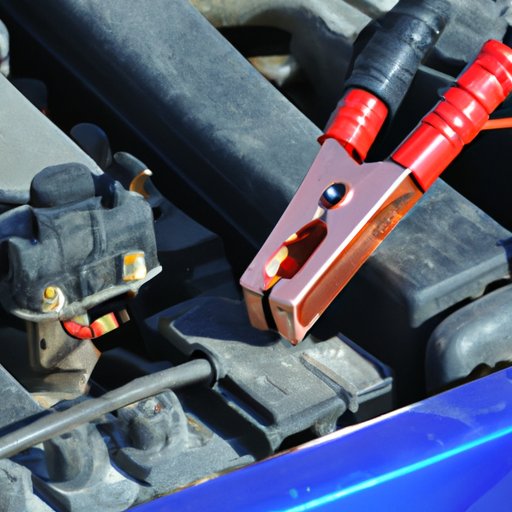I. Introduction
It’s a common problem: you turn the key, but your car won’t start. The most likely culprit is a dead battery, which can be caused by anything from leaving the lights on overnight to extreme weather conditions. Fortunately, there’s an easy fix: jump-starting the car. That’s why it’s important to know how to jump a car safely and effectively.
II. Step-by-Step Guide
Jump-starting a car may seem daunting, but it’s actually quite simple if you follow these steps:
A. Checking the car battery
Before you start, you’ll need to make sure your car battery is indeed dead. Turn on your headlights or interior lights to see if they’re dim or not working; that’s a sign of a dead battery. If your lights are bright, it might not be a battery issue after all.
B. Identifying the battery terminals
Once you’ve confirmed a dead battery, you’ll need to locate the battery terminals on both cars. The positive terminal is typically marked with a “+” symbol and is usually red, while the negative terminal is marked with a “-” symbol and is often black. Make sure to identify them correctly to avoid damaging your car’s electrical system.
C. Connecting the cables
Connect the positive (+) cable to the positive terminal on the dead battery, then connect the other end of the positive cable to the positive terminal on the charged battery. Next, connect the negative (-) cable to the negative terminal on the charged battery, then connect the other end of the negative cable to an unpainted metal surface on the dead car, such as a bolt or bracket. This is important as it helps prevent any sparks from igniting any fumes that may be present around the battery.
D. Starting the dead car
Start the car with the charged battery, and let it run for a few minutes. This will allow the battery to charge and build up some energy. Then, try to start the dead car. If it starts, great! If not, wait a few more minutes before attempting another start.
E. Disconnecting the cables
Once the dead car has started, carefully disconnect the cables in the reverse order that you connected them, starting with the negative (-) cable. Be sure to avoid touching the metal clamps on the end of the cables to prevent shock.
III. Walkthrough with Visuals
While the steps themselves are easy to follow, it can be helpful to see the process visually. Instructional videos and GIFs can provide a clear visual representation of how to jump-start a car. With their help, you can follow the steps more easily and avoid any mistakes or confusion.

IV. Common Issues and Problems
There are a few common issues that can occur during a jump-start:
- Dead battery: Sometimes the battery is just too far gone and won’t come back to life even with a jump-start.
- Faulty alternator: If your car stalls repeatedly or quickly loses power, the alternator may be faulty and not charging the battery as it should.
- Incorrect connections: Connecting the cables in the wrong order or connecting them to the wrong terminals can damage your car’s electrical system.
If any of these issues occur, you’ll need to take additional steps to address them:
- Dead battery: You’ll need to replace the battery with a new one.
- Faulty alternator: You’ll need to have it checked by a professional mechanic and replaced if necessary.
- Incorrect connections: Check the owner’s manual for your car to see the correct order of connections when jump-starting and consult with a technician if you are unsure.
V. Comparison of Different Jump-Starting Methods
There are different methods for jump-starting a car, each with its own benefits and drawbacks. Some common methods include using a portable battery pack or charger, a jump box, or a second car:
| Method | Benefits | Drawbacks |
|---|---|---|
| Portable battery pack/charger | Compact and easy to use | May not have enough charge to jump-start a completely dead battery |
| Jump box | Powerful and self-contained | More expensive than other methods |
| Second car | Readily available if you have another car nearby | Requires cables and another person to help jump-start your car |
VI. Safety Tips and Advice
Jump-starting a car involves electricity, which can be dangerous if not handled properly. Follow these safety tips to avoid any accidents:
- Wear protective gear: Gloves and safety glasses can help protect your hands and eyes from acid or sparks.
- Keep a safe distance: Stay away from the engine while jump-starting the car.
- Turn off the engine: Turn off both engines and remove the keys before connecting the cables.
- Don’t smoke: Avoid smoking or using open flames near the battery, as it can emit flammable gases.
- Remove any metal: Remove any metal jewelry or accessories, such as rings or necklaces, that could conduct electricity.
VII. Conclusion
Now that you know how to jump a car battery, you can get back on the road if your car won’t start. Remember to follow the steps carefully and stay safe by wearing protective gear and following our safety tips. If you’re unsure about anything, it’s always better to seek professional help from a mechanic or technician. With a little know-how, you’ll be back on the road in no time.
